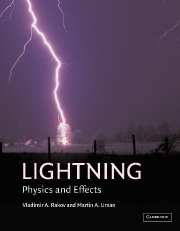Book contents
- Frontmatter
- Contents
- Preface
- 1 Introduction
- 2 Incidence of lightning
- 3 Electrical structure of lightning-producing clouds
- 4 Downward negative lightning discharges to ground
- 5 Positive and bipolar lightning discharges to ground
- 6 Upward lightning initiated by ground-based objects
- 7 Artificial initiation (triggering) of lightning by ground-based activity
- 8 Winter lightning in Japan
- 9 Cloud discharges
- 10 Lightning and airborne vehicles
- 11 Thunder
- 12 Modeling of lightning processes
- 13 The distant lightning electromagnetic environment: atmospherics, Schumann resonances, and whistlers
- 14 Lightning effects in the middle and upper atmosphere
- 15 Lightning effects on the chemistry of the atmosphere
- 16 Extraterrestrial lightning
- 17 Lightning locating systems
- 18 Deleterious effects of lightning and protective techniques
- 19 Lightning hazards to humans and animals
- 20 Ball lightning, bead lightning, and other unusual discharges
- Appendix: Books on lightning and related subjects
- Index
20 - Ball lightning, bead lightning, and other unusual discharges
Published online by Cambridge University Press: 05 June 2013
- Frontmatter
- Contents
- Preface
- 1 Introduction
- 2 Incidence of lightning
- 3 Electrical structure of lightning-producing clouds
- 4 Downward negative lightning discharges to ground
- 5 Positive and bipolar lightning discharges to ground
- 6 Upward lightning initiated by ground-based objects
- 7 Artificial initiation (triggering) of lightning by ground-based activity
- 8 Winter lightning in Japan
- 9 Cloud discharges
- 10 Lightning and airborne vehicles
- 11 Thunder
- 12 Modeling of lightning processes
- 13 The distant lightning electromagnetic environment: atmospherics, Schumann resonances, and whistlers
- 14 Lightning effects in the middle and upper atmosphere
- 15 Lightning effects on the chemistry of the atmosphere
- 16 Extraterrestrial lightning
- 17 Lightning locating systems
- 18 Deleterious effects of lightning and protective techniques
- 19 Lightning hazards to humans and animals
- 20 Ball lightning, bead lightning, and other unusual discharges
- Appendix: Books on lightning and related subjects
- Index
Summary
… a foot away from the iron rod, [he] looked at the electrical indicator again; just then a palish blue ball of fire, as big as a first, came out of the rod without any contact whatsoever. It went right to the forehead of the professor, who in that instant fell back without uttering a sound …
B. Dibner (1977) quoting the witness of a fatality attributed to ball lightning, the death of Georg Richmann in 1753 while repeating the lightning rod experiment originally suggested by Benjamin Franklin in 1750 and first performed by Thomas-François D'Alibard in 1752.
Introduction
Ball lightning (in French, boules de feu, éclair en boule, foudre globulaire; in German, Kugelblitz; in Russian, sharovaya molniya) is a phenomenon for which there exist numerous witness reports but little, if any, scientific documentation such as photographs, videotapes, or other scientific recordings. A reproduction of a woodcut depicting ball lightning “crossing a kitchen and a barn” is shown in Fig 20.1. Barry (1980b) and Stenhoff (1999) in their books presented a variety of photographs purported to be of ball lightning. Stenhoff (1999) stated that 65 such photographs have been published and attributes most of these to causes other than actual ball lightning, including street or car lights photographed by a shaking camera, fireworks, hoaxes, and film blemishes. Jennison et al. (1990) discussed and showed frames from a possible video recording of ball lightning, although the individual who took the video did not see the ball lightning through the viewfinder when he was recording a nearby storm.
Information
- Type
- Chapter
- Information
- LightningPhysics and Effects, pp. 656 - 674Publisher: Cambridge University PressPrint publication year: 2003
